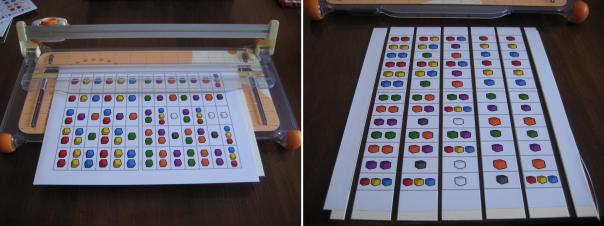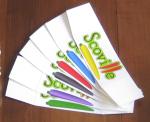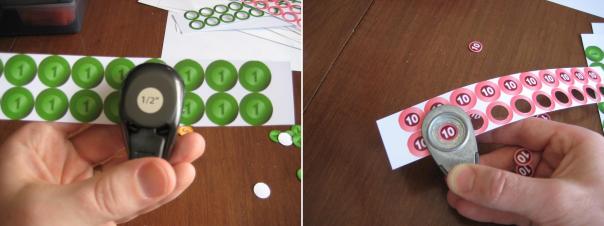Blog Archives
Character Meeples by Meeple Source
I don’t really ever upgrade my games by adding cooler components or by painting minis or anything like that. But every once in a while there is a product that can add enough to the game to make it worth it. Today I want to introduce you to Meeple Source.
I wrote about Meeple Source in my Sourcing Game Components: Meeples article last September. They make fantastic custom meeples with a ton of character. Today I am mentioning them because they have a campaign currently running on Kickstarter (KS Link). I have personally met the fine folks behind Meeple Source and they are great people with a great product.
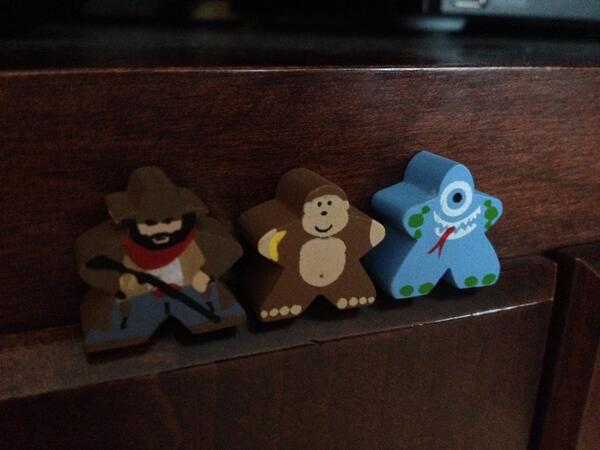
They just look so awesome!
I brought back a few of the character meeples from BGG.Con and my kids (ages 4 and 2) loved them. I wish I had bought more of them for my kids, and for my own games and game designs.
The campaign they are running has ten days remaining. They are over $70,000 and they have more stretch goals to go.
So far they have added some awesome stuff to the campaign. They added custom character meeples for a few games, like Tiny Epic Kingdoms, Lords of Waterdeep and Pandemic. They have three custom meeples from other companies like Miniature Market, Board Game Geek, and Tasty Minstrel Games. These are free to people who pledge $9 or more. They have also added cool viruses, germs, or plagues for Pandemic.
Here are just a few of the MANY meeples you can get:
I won’t get into the pledge tiers for the campaign because there are a ton of them. But go check it out and choose some sweet character meeples for yourself, or your kids, or your parents, or to hide in your co-workers office. I’m backing to get a fresh set of 10 different meeples, but since they keep adding awesome content I have no idea which 10 I’ll choose in the end.
Sourcing Game Components: Meeples

A Mash of Meeples!
Last week I posted the first in this series of four articles about sourcing components for your board game designs. That article was about sources for cards. Today I’m covering my go-to sources for meeples to use in games. Here’s the list of what I’m covering in this whole “Sourcing” series:
- Sourcing Cards – 9/5/13
- Sourcing Meeples – Today!
- Sourcing Chits – 9/19/13
- Sourcing Dice – 9/26/13
So that’s the list I’m working with. Those are probably the four main components you are likely to use in a prototype. When I refer to “Meeples” I am referring to the components that are used to mark your spot or location on the board or player mats. Meeples can mean different things to different people.
As I wrote last week I want to give credit to the list that inspired me to write these articles. This list is much more exhaustive than mine since I am just highlighting a few of the major suppliers. But here’s the list so you can check it out yourself:
I have picked a few of those sources to add to the ones I also use. And like last week I’ll start with The Game Crafter since they are my go-to source for these things.

The Game Crafter
 First things first: If you order pawns or anything that doesn’t have to be printed, you still need to wait your turn in the production queue. I recently placed an order for 30 pawns that cost a total of about $5 and I started out as #550 in the queue. The estimated ship date was October first. I know that they have the pawns just sitting over there. I bet I could drive over and simply ask if I could buy the 30 pawns and get them the same day.
First things first: If you order pawns or anything that doesn’t have to be printed, you still need to wait your turn in the production queue. I recently placed an order for 30 pawns that cost a total of about $5 and I started out as #550 in the queue. The estimated ship date was October first. I know that they have the pawns just sitting over there. I bet I could drive over and simply ask if I could buy the 30 pawns and get them the same day.

The avatar pawn
Here is their page for pawns: The Game Crafter – Pawns
I like to use the Avatar pawns. They cost 14 cents each and are not ugly. These have worked well for me in the past and I’m looking forward to getting my set of new pawns so that I have enough for a few more prototype copies of Scoville. They are just simple and easy. No need to get complicated for a prototype! But if you want to mix things up, this next source might be the right one for you…

Meeple Source

My favorite is the pirate with the peg leg!
I’ve never bought from Meeple Source, but after giving their site a long, drooling look I think they might serve me well in the future. They offer the following categories of meeples from which to choose:
- Standard Meeples
- Mega Meeples
- Mini Meeples
- Super Mega Meeples
- Character Meeples
- Camo Meeples
- Sets of Meeples
- “Misfit” Meeples
Wow. And if that wasn’t enough, you can also check out their Plush Meeples!
This site has a TON of meeples to offer and I’m afraid I should have listed them lower in this article because I feel there really isn’t any sense for you to continue reading. But please continue anyway!

SpielMaterial.de

Is that Gandalf the Red??
If you happen to be an awesome reader from Europe, I’m glad you’re here. If you are interested in meeples or pawns, then you might be interested in ordering from SpielMaterial.de. They are a European vendor of board game component awesomeness.
Here are some links:
They have so much to offer that it’s worth just browsing on their website. You might get inspired for a game design simply by looking at all the things they can sell you.

Boards & Bits
I have ordered from Boards & Bits in the past and was pleased with the service I received. Boards & Bits must have a HUGE warehouse to accommodate all the products that they carry. Their options go well beyond pawns and meeples. Their website isn’t the greatest since it is a little difficult to navigate, but they just offer so many things that I can easily look past that.
You will mostly find typical meeples and pawns at Boards & Bits. They don’t offer the painted meeples the way that Meeple Source and SpielMaterial do. But if you want a cheap source for prototype worthy pawns, then perhaps Boards & Bits is for you!
 CraftParts.com
CraftParts.com

What a lovely little meeple family!
If you are only interested in little wooden people, then maybe you should check out Craft Parts. They offer a small assortment of wooden people figures that might work great in your prototype.
CraftParts.com – Little Wooden People
These components range in size from 1 1/8th inch to 3 9/16th inches. So these are quite a bit larger than your standard meeples. But maybe that’s what your looking for because you typically play games with giants. These will help those giants grab onto the pawns much easier!
***
So there are a few of the numerous online sources for meeples and pawns. If there are any major vendors that I have overlooked, please let me know and I will update this list. Thanks for reading!
Prototyping Techniques Applied to Scoville
 While at Protospiel I heard a lot of kind words for the quality of my prototype of Scoville. So today I am sharing my prototyping process with you. I hope that it can help you make a quality prototype that you are confident about.
While at Protospiel I heard a lot of kind words for the quality of my prototype of Scoville. So today I am sharing my prototyping process with you. I hope that it can help you make a quality prototype that you are confident about.
When I was first getting into board game design I was a little overwhelmed by what it took to make a prototype. I watched a few prototyping videos on BoardGameGeek.com. Those only made me shy away from the whole process. It can be intimidating. But today you can learn that it isn’t perhaps as daunting as you might think.
Overview of my Process
 First things first: you need a game concept. Assuming you’ve got a great idea in mind it’s time to start prototyping. Early on in my board game career I was designing a heavy Euro game. I waited to make a prototype until I had worked through all the details of the game. That was a mistake. It is my recommendation to make prototype components of your game as early as possible. For example: If you have an auction in your game, test it independently from the other mechanics. Test each mechanic individually and test them early on. There is no point to design an entire game only to find out that the individual parts don’t work.
First things first: you need a game concept. Assuming you’ve got a great idea in mind it’s time to start prototyping. Early on in my board game career I was designing a heavy Euro game. I waited to make a prototype until I had worked through all the details of the game. That was a mistake. It is my recommendation to make prototype components of your game as early as possible. For example: If you have an auction in your game, test it independently from the other mechanics. Test each mechanic individually and test them early on. There is no point to design an entire game only to find out that the individual parts don’t work.
Once the individual elements seem to work then you can try to put them all together to make a full game out of them. Here is a rule of thumb I try to follow:
Never add complications unless they are absolutely necessary.
This is a difficult thing to do. It is always easier to add another rule or add another component. But if you want to make a good game, focus on the innovative mechanic rather than all the little rules about the rest of the game. Keep it simple.
So I start with a concept. I usually write about 10 pages of notes and sketches about that concept. Then I’ll go ahead and start prototyping (this is what I’m covering today). Once I have a prototype ready then I’ll play test it at least 10 times. This will give me a solid amount of feedback. Only after testing 10 times will I apply any changes. Here’s another rule of thumb:
Don’t try to change things in the game on the fly, and don’t change more than one thing at a time.
Following this rule is critical, especially the part about changing more than one thing at a time. If you change more than one thing it can be difficult to know which of the things you changed made the game better (or worse). Change one thing at a time and test it profusely. So I apply feedback and adjust things after 10 play tests. Once the game has gone through the PROTOTYPE – PLAY TEST – APPLY FEEDBACK phase several times to the point where there are only very subtle changes then I get to the point where I am confident about contacting publishers about it. There is no point in pitching a game unless you’ve gotten it to the point where you are proud of your product and confident to show it off.
Getting Started: What do I need?
When making a prototype I usually begin with a spreadsheet. A spreadsheet allows you to create custom tiles or cards very easily. You can print them out yourself and turn them into quality prototype components. Here’s a list of everything I use(d) to create a copy of Scoville:
- Spreadsheet software
- Graphic Design Software (I prefer Inkscape, but The Gimp is also very useful)
- Paper (Plain paper for first prototypes, Glossy photo paper for pitch-able versions)
- Thick card stock – As thick as you prefer, though the thicker it is the more difficult it is to cut.
- Components: cubes/meeples/coins
- Circle Punch
- Paper Cutter (I have this one)
- Bingo chips
- Glue Stick
- Scissors
- Gerber Baby Food Containers – if you don’t have kids find some friends who do and beg them to save these for you!
Here is a picture of all the components that go into the game:
That’s everything (except a box) I need to make a copy of Scoville. Let’s walk through the prototyping (physical creation) process.
Make it Rain! Or Something Like That
Assuming you’ve taken your concept and created artwork that suits you, it’s time to actually make something real for testing. What that means to me is that it’s time to print stuff out! Scoville has 13 pages of printing required for a full copy. The next step is to adhere those pages to the thick card stock. I like to buy the stuff that is as thick as standard board game chit board. This gives me the feeling like I am playing a real game when I test it.
So I use the glue stick and cover the back of the paper and then stick it to the card stock. Once I’ve got them all glued down I can start to cut them to size. Since the large card stock boards I buy are too big for my paper cutter I run a scissors through them to separate the difference components before using the paper cutter.
Then I use the paper cutter to trim the fat and make them nice and clean. Shown here as an example is the first cuts done to the auction tiles:
I then go ahead and cut each tile out individually and end up with a pile of nice thick quality components:
I continue this process for all of the components in the game.
Making Player Shields
Another part that seemed a little overwhelming to me was the production of player shields. But I found a nice, easy way to make them. If you don’t want pictures on them then just cut some paper and fold it. If you want pictures or logos then follow this procedure:
-
Print the logos.
- Cut the logos to a rectangular size.
- Glue the logo centered on a sheet of thin card stock.
- Angle cut each edge so that it will lean when completed.
- Fold gently.
For Scoville I made the artwork on the shields include the player color. Making your own player shields rather than using shields from games you own can really spice up your prototype.
Making Money
One of the more tedious things in this process is making my own coins. I don’t have to make it as hard on myself as I do, but I prefer a really professional looking prototype.
It would be much easier to simply write a money value on the plastic bingo chips with a marker. This would make them more difficult to read and they wouldn’t look as nice.
So my process for making coins is this:
- Create the artwork.
- Insert the coin images into a document file.
- Print the document.
- Punch the coins out of the paper.
- Adhere them to the bingo chips.
Here is a tip for punching, if you use a circle punch like mine:
If you hold the punch like it seems it should be held then you have to rely on the little plastic bump guides on the side of it. Just flip the punch over and you can visually align the punch with the coin. This makes it so much easier!
Once you’ve got them all punched you can simply glue them to the bingo chips. I recommend watching something on TV that is really attention grabbing, so that it draws your attention from the tedium of gluing little circles to bingo chips.
If you don’t like the idea of gluing circles to bingo chips then go ahead and use the same thick card stock that you’ve been using. Just be aware that the circle punch may not punch through the thick card stock. That’s why I went with the bingo chips.
The Final Product
Once you’ve got all the components glued-punched-cut-etc. then it’s time to put it all together. Here is a before and after picture showing the reduction in volume for Scoville:
To continue with the theme of a quality, pitch-able prototype I like to use a nice container to hold everything. You can buy these at Target.com or you can find different colors in the store. They are only $5. I should also note that these fit into a Medium Flat Rate Priority box from the United States Postal Service. So it is pretty easy to mail one off to a publisher!
Now you’ve got your container so throw in the components, a couple copies of the rules, a business card, and you’re ready to pitch your game! Note, you do not need to have a high quality prototype to pitch a game. I am just a firm believer in making a good first impression. Here’s what Scoville looks like in it’s full prototype form:
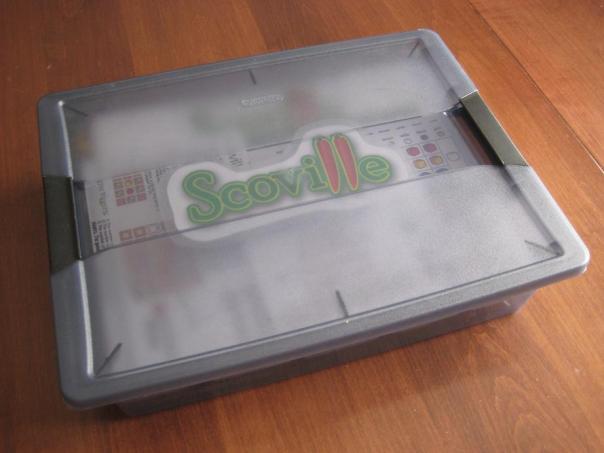
This is the third copy of Scoville in existence! May the other two copies in the wild prosper and flourish!
How Much Is It Gonna Cost Me?
I mentioned earlier that you can make an high quality prototype that is also inexpensive. Here is a rundown of the costs for a full copy of Scoville:
- 13 sheets of glossy photo paper: $3
- Printer Ink (I buy cheap Non-OEM ink off Amazon): ~$2
- Glue Stick: $3.30
- 4-Pack of Thick Card Stock: $13
- Bingo Chips: $0.50
- Meeples ($0.14 each): $0.84 – I live near The Game Crafter so I can pick them up and avoid paying shipping costs
- Plastic Cubes (250): $7 – I bought a tub of 1000 cubes for $25 (shipping included) from EAI
So the total for a high quality prototype for Scoville costs me under $30. So maybe you wouldn’t characterize that as inexpensive. But when $30 can allow you to create a pitch-able high quality prototype that might catch a publisher’s eye, I don’t think $30 is too bad.
What techniques do you use? I wanted to point out that I did not write about making cards. Most people, when making prototype cards will purchase penny sleeves, insert their custom made cards, and make them thicker by dropping in a M:TG card. I don’t use cards in Scoville, so I didn’t include that.
I hope that you enjoyed this article. It has been a fun process for me to figure out some of the best ways to make a prototype. If you have any ways to make the process more efficient, please leave a comment so others can see!




